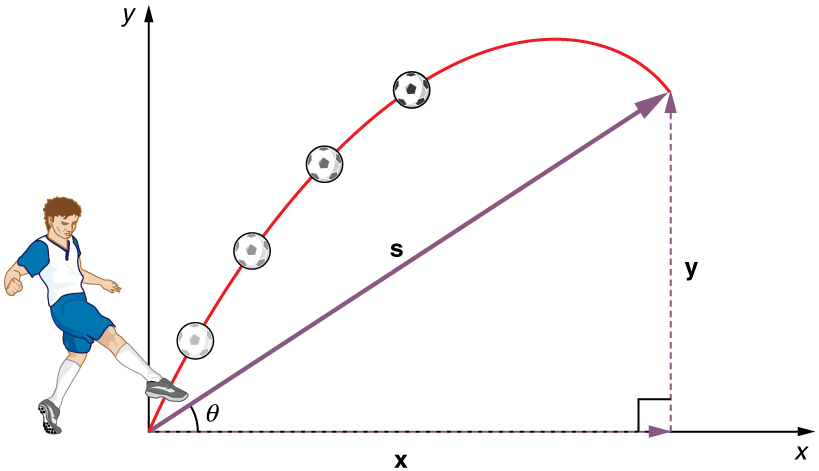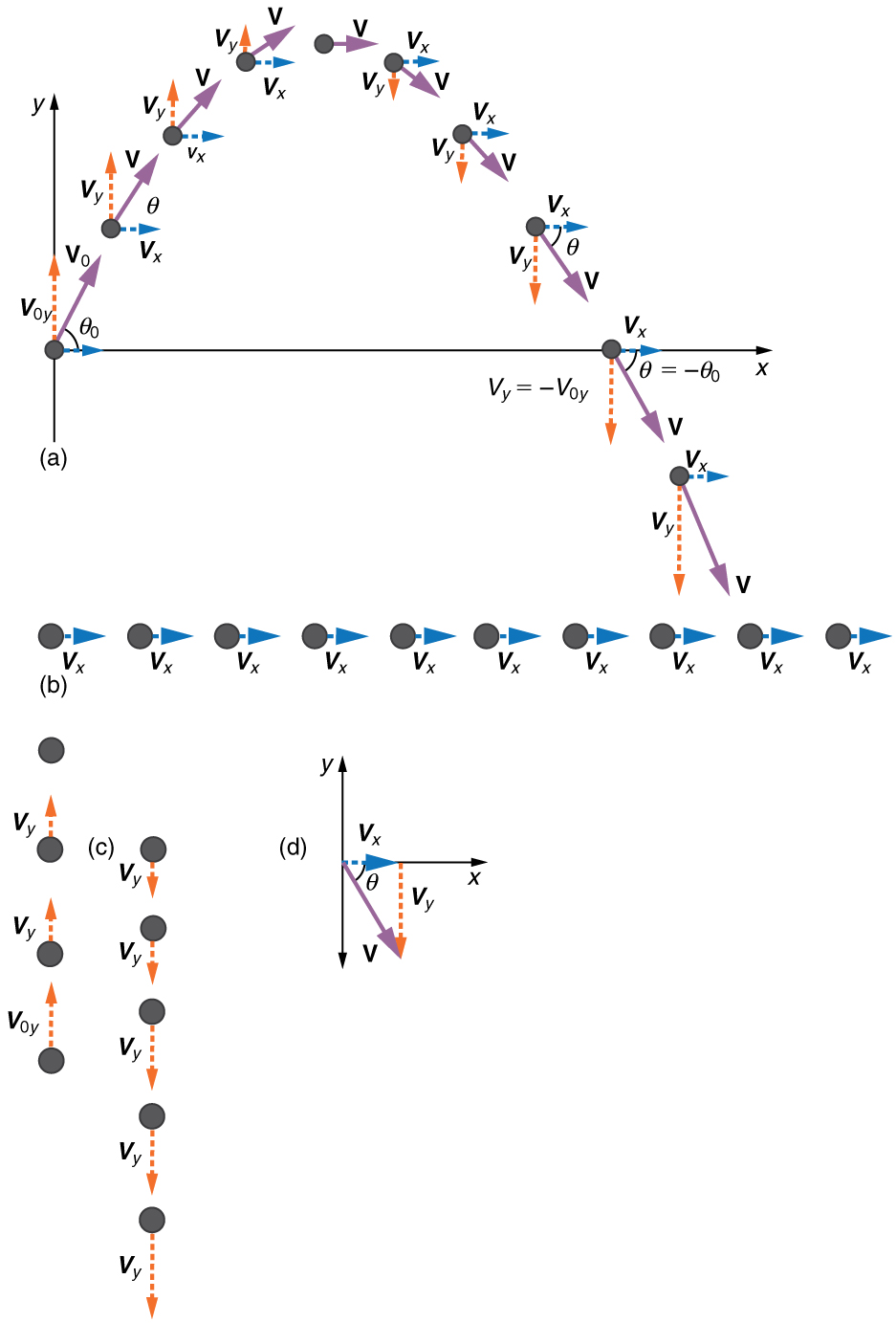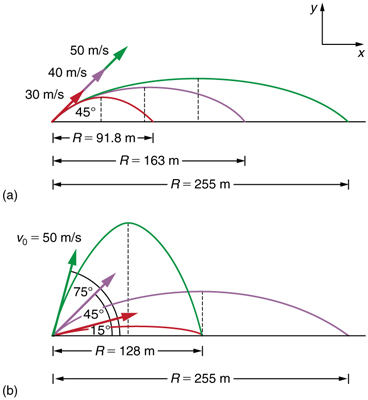28 4.4 Projectile Motion
Summary
- Identify and explain the properties of a projectile, such as acceleration due to gravity, range, maximum height, and trajectory.
- Determine the location and velocity of a projectile at different points in its trajectory.
- Apply the principle of independence of motion to solve projectile motion problems.
Projectile motion is the motion of an object thrown or projected into the air, subject to only the acceleration of gravity. Since the object or body is under the effects of a constant acceleration (-9.8m/s2 in the vertical and 0 in the horizontal plane) its trajectory is predictable based on the magnitude and direction of its initial velocity at take-off. The object or body is called a projectile, and its path is called its trajectory. The motion of falling objects is a simple one-dimensional type of projectile motion in which there is no horizontal movement. In this section, we consider two-dimensional projectile motion, such as that of a football or other object for which air resistance is negligible.
PHET EXPLORATIONS: PROJECTILE MOTION
Blast a Buick out of a cannon! Learn about projectile motion by firing various objects. Set the angle, initial speed, and mass. Add air resistance. Make a game out of this simulation by trying to hit a target.

The trajectory of a projectile takes on a parabolic shape. The very top of the trajectory is called the apex. If a projectile takes off and lands at the same height, the trajectory is symmetrical. This means that the projectile travels the same distance in both the vertical and horizontal plane on the way up, as on the way down. The time for the projectile to reach the apex, is the same as the time for the projectile to come back to the initial height.
The most important fact to remember here is that motions along perpendicular axes are independent and thus can be analyzed separately. Vertical and horizontal motions are independent. The key to analyzing two-dimensional projectile motion is to break it into two motions, one along the horizontal axis and the other along the vertical. (This choice of axes is the most sensible, because acceleration due to gravity is vertical—thus, there will be no acceleration along the horizontal axis when air resistance is negligible.) As is customary, we call the horizontal axis the x-axis and the vertical axis the y-axis. Figure 1 illustrates the notation for displacement, where
Of course, to describe motion we must deal with velocity and acceleration, as well as with displacement. We must find their components along the x– and y-axes, too. We will assume all forces except gravity (such as air resistance and friction, for example) are negligible. The components of acceleration are then very simple: ay=-g=-9.81 m/s2. Because gravity is vertical, ax=0. Both accelerations are constant, so the following kinematic equations of uniformly accelerated motion can be used.
EQUATIONS OF UNIFORMLY ACCELERATED MOTION
(You can use these when acceleration is a constant value)

Given these assumptions, the following steps are then used to analyze projectile motion:
Step 1. Resolve or break the initial velocity of the projectile into horizontal and vertical components along the x- and y-axes. The magnitude of the components of initial velocity $\vec{\textbf{v}}$ along these axes are x and y. The magnitudes of the components of the velocity in this case $\vec{\textbf{v}}$ are vx = v cos θ and vy = v sin θ, where v is the magnitude of the velocity and θ is its direction, as shown in Figure 2. Initial values are denoted with a subscript 0 instead of “i”.
Step 2. Treat the motion as two independent one-dimensional motions, one horizontal and the other vertical. The kinematic equations that you should use in the vertical direction include:
Step 3. Solve for the unknowns in the two separate motions—one horizontal and one vertical. Note that the only common variable between the motions is time t. But consider this: you are likely interested in how far (dx) and how high(dy) the projectile travelled. If you want to know how far a projectile travelled you are interested in the entire trajectory. If you are interested in how high the projectile traveled, you are interested in the position of the projectile at its highest point which is halfway through a symmetrical trajectory. Which means you want to calculate dy at the halfway mark (half the total time).
Step 4. Answer the question asked in the problem.

DEFINING A COORDINATE SYSTEM
It is important to set up a coordinate system when analyzing projectile motion. One part of defining the coordinate system is to define an origin for the x and y positions. Often, it is convenient to choose the initial position of the object as the origin such that xi = 0 and yi = 0. It is also important to define the positive and negative directions in the x and y directions. Typically, we define the positive vertical direction as upwards, and the positive horizontal direction is usually the direction of the object’s motion. When this is the case, the vertical acceleration, ay, takes a negative value (since it is directed downwards towards the Earth). However, it is occasionally useful to define the coordinates differently. For example, if you are analyzing the motion of a ball thrown downwards from the top of a cliff, it may make sense to define the positive direction downwards since the motion of the ball is solely in the downwards direction. If this is the case, ay takes a positive value.
One of the most important things illustrated by projectile motion is that vertical and horizontal motions are independent of each other. On level ground, we define range to be the horizontal distance (R) traveled by a projectile. Let us consider projectile range further.

How does the initial velocity of a projectile affect its range? Obviously, the greater the initial speed vi, the greater the range, as shown in Figure 5(a). The initial angle θi also has a dramatic effect on the range, as illustrated in Figure 5(b). For a fixed initial speed, such as might be produced by a cannon, the maximum range is obtained with θi= 45°. This is true only for conditions neglecting air resistance. If air resistance is considered, the maximum angle is approximately 38°. Interestingly, for every initial angle except 45° there are two angles that give the same range—the sum of those angles is 90°.
Summary
- Projectile motion is the motion of an object through the air that is subject only to the acceleration of gravity.
- To solve projectile motion problems, perform the following steps:
- Determine a coordinate system. Then, resolve the initial velocity of the object in the horizontal and vertical components.
- Note that velocity final (vfy = 0 at the apex for y and vfx = vix at the end for x) are known. The accelerations in x and y are also known as they are constants (ax = 0, ay = -9.81 m/s2)
- Calculate the maximum height of the projectile (dy) and the time it took for the projectile to reach the apex (t 1/2) using the following equations:
4. Double the time found with the equations for y, to account for the entire trajectory (t = 2*t 1/2).
5. Calculate the maximum range (dx) of the projectile using the following equation:
Conceptual Questions
1: Answer the following questions for projectile motion on level ground assuming negligible air resistance (the initial angle being neither 0° nor 90°): (a) Is the velocity ever zero? (b) When is the velocity a minimum? A maximum? (c) Can the velocity ever be the same as the initial velocity at a time other than at t = 0? (d) Can the speed ever be the same as the initial speed at a time other than at t = 0?
2: Answer the following questions for projectile motion on level ground assuming negligible air resistance (the initial angle being neither 0° nor 90°): (a) Is the acceleration ever zero? (b) Is the acceleration ever in the same direction as a component of velocity? (c) Is the acceleration ever opposite in direction to a component of velocity?
3: For a fixed initial speed, the range of a projectile is determined by the angle at which it is fired. For all but the maximum, there are two angles that give the same range. Considering factors that might affect the ability of an archer to hit a target, such as wind, explain why the smaller angle (closer to the horizontal) is preferable. When would it be necessary for the archer to use the larger angle? Why does the punter in a football game use the higher trajectory?
4: During a lecture demonstration, a professor places two coins on the edge of a table. She then flicks one of the coins horizontally off the table, simultaneously nudging the other over the edge. Describe the subsequent motion of the two coins, in particular discussing whether they hit the floor at the same time.
Problems & Exercises
1: A projectile is launched at ground level with an initial speed of 50.0 m/s at an angle of 30.0° above the horizontal. It strikes a target above the ground 3.00 seconds later. What are the x and y distances from where the projectile was launched to where it lands?
2: A ball is kicked with an initial velocity of 16 m/s in the horizontal direction and 12 m/s in the vertical direction on level ground. (a) At what speed does the ball hit the ground? (b) For how long does the ball remain in the air? (c)What maximum height is attained by the ball?
3: A ball is thrown horizontally from the top of a 60.0-m building and lands 100.0 m from the base of the building. Ignore air resistance. (a) How long is the ball in the air? (b) What must have been the initial horizontal component of the velocity? (c) What is the vertical component of the velocity just before the ball hits the ground? (d) What is the velocity (including both the horizontal and vertical components) of the ball just before it hits the ground?
4: (a) A daredevil is attempting to jump his motorcycle over a line of buses parked end to end by driving up 32° ramp at a speed of 40.0 m/s (144 km/h). How many buses can he clear if the top of the takeoff ramp is at the same height as the bus tops and the buses are 20.0 m long? (b) Discuss what your answer implies about the margin of error in this act—that is, consider how much greater the range is than the horizontal distance he must travel to miss the end of the last bus. (Neglect air resistance.)
5: An archer shoots an arrow at a 75.0 m distant target; the bull’s-eye of the target is at same height as the release height of the arrow. (a) At what angle must the arrow be released to hit the bull’s-eye if its initial speed is 35.0 m/s? In this part of the problem, explicitly show how you follow the steps involved in solving projectile motion problems. (b) There is a large tree halfway between the archer and the target with an overhanging horizontal branch 3.50 m above the release height of the arrow. Will the arrow go over or under the branch?
6: A rugby player passes the ball 7.00 m across the field, where it is caught at the same height as it left his hand. (a) At what angle was the ball thrown if its initial speed was 12.0 m/s, assuming that the smaller of the two possible angles was used? (b) What other angle gives the same range, and why would it not be used? (c) How long did this pass take?
7: Verify the ranges for the projectiles in Figure 5(a) for θ = 45° and the given initial velocities.
8: Verify the ranges shown for the projectiles in Figure 5(b) for an initial velocity of 50 m/s at the given initial angles.
10: In the standing broad jump, one squats and then pushes off with the legs to see how far one can jump. Suppose the extension of the legs from the crouch position is 0.600 m and the acceleration achieved from this position is 1.25 times the acceleration due to gravity, g. How far can they jump? State your assumptions. (Increased range can be achieved by swinging the arms in the direction of the jump.)
11: The world long jump record is 8.95 m (Mike Powell, USA, 1991). Treated as a projectile, what is the maximum range obtainable by a person if he has a take-off speed of 9.5 m/s? State your assumptions.
12: A football quarterback is moving straight backward at a speed of 2.00 m/s when he throws a pass to a player 18.0 m straight downfield. (a) If the ball is thrown at an angle of 25° relative to the ground and is caught at the same height as it is released, what is its initial speed relative to the ground? (b) How long does it take to get to the receiver? (c) What is its maximum height above its point of release?
13: Suppose a soccer player kicks the ball from a distance 30 m toward the goal. Find the initial speed of the ball if it just passes over the goal, 2.4 m above the ground, given the initial direction to be 40° above the horizontal.
14: Can a goalkeeper at her/ his goal kick a soccer ball into the opponent’s goal without the ball touching the ground? The distance will be about 95 m. A goalkeeper can give the ball a speed of 30 m/s. Use the maximum range equation here, assuming the launch angle is 45 degrees.
15: The free throw line in basketball is 4.57 m (15 ft) from the basket, which is 3.05 m (10 ft) above the floor. A player standing on the free throw line throws the ball with an initial speed of 7.15 m/s, releasing it at a height of 2.44 m (8 ft) above the floor. At what angle above the horizontal must the ball be thrown to exactly hit the basket? Note that most players will use a large initial angle rather than a flat shot because it allows for a larger margin of error. Explicitly show how you follow the steps involved in solving projectile motion problems.
16: In 2007, Michael Carter (U.S.) set a world record in the shot put with a throw of 24.77 m. What was the initial speed of the shot if he released it at a height of 2.10 m and threw it at an angle of 38.0° above the horizontal?
17: A basketball player is running at 5.00 m/s directly toward the basket when he jumps into the air to dunk the ball. He maintains his horizontal velocity. (a) What vertical velocity does he need to rise 0.750 m above the floor? (b) How far from the basket (measured in the horizontal direction) must he start his jump to reach his maximum height at the same time as he reaches the basket?
18: A football player punts the ball at a 45.0° angle. Without an effect from the wind, the ball would travel 60.0 m horizontally. (a) What is the initial speed of the ball? (b) When the ball is near its maximum height it experiences a brief gust of wind that reduces its horizontal velocity by 1.50 m/s. What distance does the ball travel horizontally?
Glossary
- air resistance
- a frictional force that slows the motion of objects as they travel through the air; when solving basic physics problems, air resistance is assumed to be zero
- kinematics
- the study of motion without regard to mass or force
- motion
- displacement of an object as a function of time
- projectile
- an object that travels through the air and experiences only acceleration due to gravity
- projectile motion
- the motion of an object that is subject only to the acceleration of gravity
- range
- the maximum horizontal distance that a projectile travels
- trajectory
- the path of a projectile through the air
Solutions
Problems & Exercises
1: x = 130 m y=30.9 m
2: (a) 20 m/s (b) 1.22 seconds (c) 9.8 m
3: (a) 3.50 s (b) $\boldsymbol{28.6\textbf{ m/s}}$ (c) $\boldsymbol{34.3\textbf{ m/s}}$ (d) $\boldsymbol{44.7\textbf{ m/s}}$, $\boldsymbol{50.2^0}$ below horizontal
5: (a)
7:
9: $\boldsymbol{1.50\textbf{ m}}$, assuming launch angle of
12:
13: (a) $\boldsymbol{-0.486\textbf{ m}}$ (b) The larger the muzzle velocity, the smaller the deviation in the vertical direction, because the time of flight would be smaller. Air resistance would have the effect of decreasing the time of flight, therefore increasing the vertical deviation.
14: No, the maximum range (neglecting air resistance) is about 92 m.
16: 15.0 m/s
18: (a) 24.2 m/s (b) The ball travels a total of 57.4 m with the brief gust of wind.

